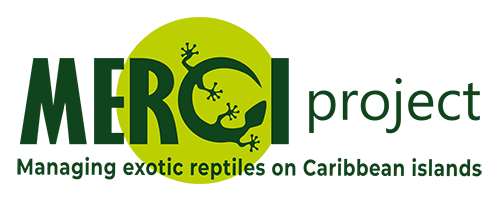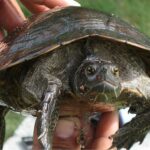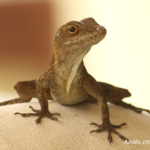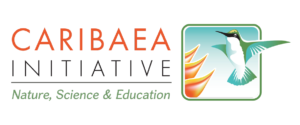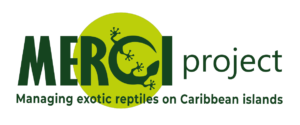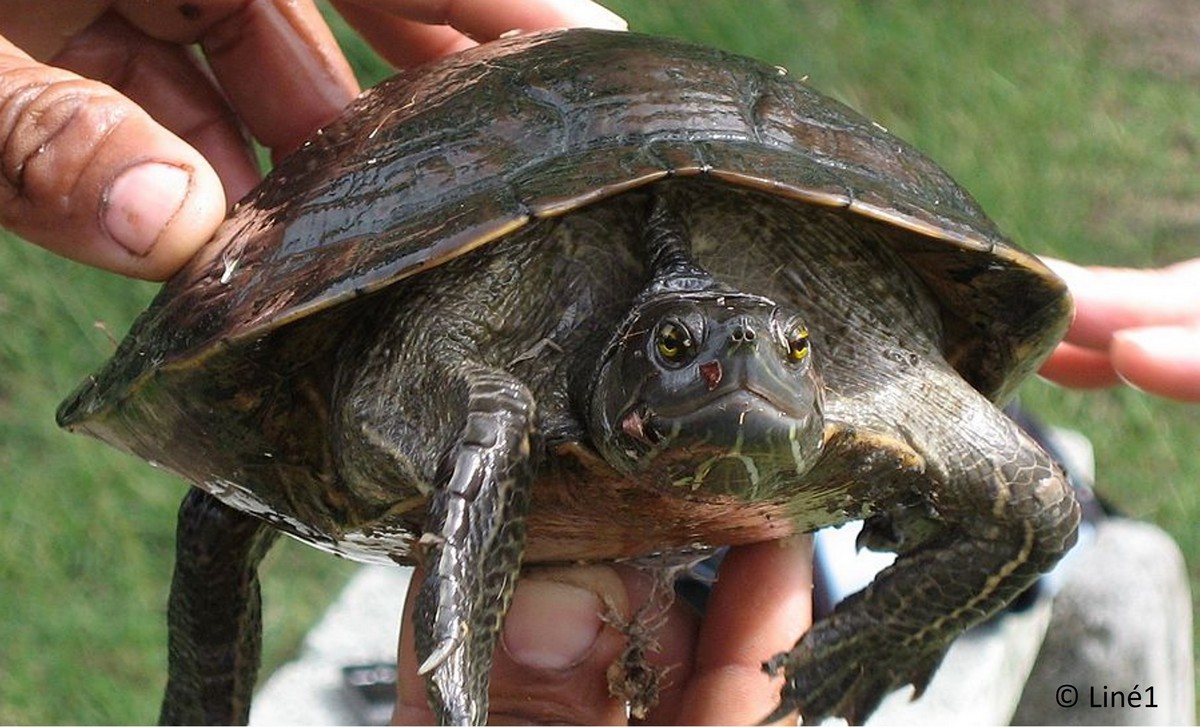
- Common name: Antillean slider, Central Antillean slider, Puerto Rican slider
- Scientific name : Trachemys stejnegeri (Schmidt, 1928)
- Local name: Trachémyde de Stejneger, Trachémyde de Porto Rico, Tortue peinte
- Order : Testunides
- Family : Emydidae
Description
Morphology. Medium-sized freshwater turtle, Trachemys stejnegeri is characterised by a dark red or brownish supra-temporal stripe accompanied by several discrete stripes between the orbit and the supra-temporal (Barbour and Carr, 1940). Head and limbs are brown or olive-brown in colour (Seidel, 1988; Barbour and Carr, 1940). The plastron is yellow to orange in all individuals, except the oldest ones, and present a symmetrical and wavy shape (Seidel, 1988). The carapace is relatively smooth, weakly streamlined, and serrated on the posterior part. Its colour varies from light brown to chestnut. In adults, the carapace is usually unmarked except for clear bands or discoloured ocelli on the margins. In juveniles, the pleura present a dark spot surrounded by a yellow or orange ring (Seidel, 1988; Barbour and Carr, 1940).
Standard body size (length of the carapace). males: 105 to 210 mm; females: 110 to 280 mm (Seidel, 1988; Jones and Willey, 2011)
Sexual dimorphism. Male Trachemys have elongated tails and a cloaca extending from the posterior part of the carapace, while females have a shorter tail and a cloaca that does not extend beyond the posterior part of the carapace (Seidel and Ernst 2012).
Females are generally larger than males (Jones and Willey, 2011).
Variations.
Possible confusion with other species. Confusion is possible with several species of the genus Trachemys, such as T. decorata. T. stejnegeri and T. decorata are relatively close geographically and occur in sympatry in Haiti and the Dominican Republic (Seidel and Inchaustegui, 1984). These two species are distinguished by the colour of the supra-temporal stripes: deep or dark red in T. stejnegeri, yellow or pale green in T. decorata (Barbour and Carr, 1940; Seidel, 1988; Fritz, 1991).
Distribution
Native. Puerto Rico (Culebra and Vieques), Great Inagua (Bahamas), Haiti, Dominican Republic (Seidel et Inchaustegui, 1984; Jones et Willey, 2011; Powell et al., 2011; Rhodin et al., 2017)
Introduced. Caribbean: Guadeloupe (Breuil, 2002; Breuil et al., 2009; Powell et al., 2011), Dominica, (Seidel and Adkins, 1987; Seidel, 1988), Turks and Caicos.
Biology and ecology
Habitat. Trachemys stejnegeri can cope with a great diversity of natural and anthropized habitats (Seidel and Inchaustegui, 1984; Jones et Willey, 2011). Usually observed in shallow, soft-bottomed water bodies, swamps and rivers (Seidel et Inchaustegui, 1984; Jones et Willey, 2011).
Diet. Omnivore (in captivity).
Reproduction. The nesting season happen from April to July. Three to fourteen eggs are laid per nest.
Behaviour.
Impact and management of introduced populations
Impact. Little is known about the impact of Trachemys stejnegeri on native ecosystems in introduced regions.
Management. No targeted control measures have been established in the different regions where the species has been introduced.
Bibliography
- Barbour, T., Carr Jr., A. F. (1940). Antillean Terrapins. Memoirs of the Museum of Comparative Zoölogy , 54, 379–415.
- Breuil, M. (2002). Histoire naturelle des amphibiens et reptiles terrestres de l’archipel Guadeloupéen. Guadeloupe, Saint-Martin, Saint Barthélemy. Patr. Nat., 339.
- Breuil, M., Guiougou, F., Questel, K., & Ibéné, B. (2009). Modifications du peuplement herpétologique dans les Antilles françaises : disparitions et espèces allochtones. 2ème partie : Reptiles. Le Courrier de La Nature, 251, 36–43.
- Conseil de l’Union Européenne (1997). Règlement (CE) nº 338/97 du Conseil du 9 décembre 1996 relatif à la protection des espèces de faune et de flore sauvages par le contrôle de leur commerce. 69.
- Fritz, U. (1991). Contribution to the knowledge of the Hispaniolan Slider Trachemys decorata (Barbour & Carr 1940). Sauria 1: 11-14.
- Jones, M. T., & Willey, L. L. (2011). Trachemys stejnegeri (Central Antillean Slider). Herpetological Review, 42(4), 527.
- Parlement Européen (2014). Règlement (UE) no 1143/2014 du Parlement Européen et du conseil du 22 octobre 2014 relatif à la prévention et à la gestion de l’introduction et de la propagation des espèces exotiques envahissantes. 21.
- Powell, R., Henderson, R. W., Farmer, M. C., Breuil, M., Echternacht, A. C., van Buurt, G., … Perry, G. (2011). Introduced amphibians and reptiles in the Greate Caribbean: Patterns and conservation implications. Conservation of Caribbean Island Herpetofaunas, 1, 63–143. https://doi.org/10.1163/ej.9789004183957.i-228
- Rhodin, A. G. J., Iverson, J. B., Bour, R., Fritz, U., Georges, A., Shaffer, H. B., & Dijk, P. P. van. (2017). Turtles of the world. Annotated Checklist and Atlas of taxonomy, synonymy, distribution, and conservation status (8th Ed.). In A. G. J. Rhodin (Ed.), Chelonian Research Monographs (Vol. 7). New York: Chelonian Research Foundation and Turtle Conservancy.
- Seidel, M. E. (1988). Trachemys stejnegeri (Schmidt) Central Antillean slider. Catalogue of American Amphibians and Reptiles, 441(1984), 441.1-441.3.
- Seidel, M. E., & Adkins, M. D. (1987). Biochemical comparisons among West Indian Trachemys (Emydidae: Testudines ). Copeia, 1987(2), 485–489.
- Seidel, M. E., & Ernst, C. H. (2012). Trachemys Agassiz Sliders. Catalogue of American Amphibians and Reptiles 891: 1-17.
- Seidel, M. E., & Inchaustegui Miranda, S. J. (1984). Status of the Trachemyd Turtles (Testudines: Emydidae) on Hispaniola. Journal of Herpetology, 18, 468.
